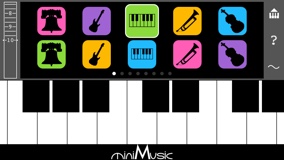 Frequently Asked Questions
Frequently Asked Questions
Why don't I hear any sound?
Make sure your iPhone or iPad is not switched to silent mode. Also make sure your iPhone or iPad volume isn't turned all the way down. Pianofly also has a volume slider in the top left corner of the screen; make sure it is turned up. Finally, if you are listening to Pianofly on your iPhone or iPad speaker, you may not be able to hear very low notes; the hardware cannot reproduce low bass frequencies well. Try scrolling up the keyboard and see if you can hear higher notes.
Why do I sometimes hear a crackling sound?
When you play three or four keys at once, the combined volume can be three or four times greater than just playing one note. If the total combined volume is too high, you may hear some "clipping". Pianofly has a built in "Auto-gain" feature so that when this happens Pianofly will turn down the master volume just enough for the clipping to go away. To completely avoid clipping you must keep the master volume at a lower setting. We give you the option to turn the volume all the way up to 10 (which you may want when only playing one or two notes), but you risk some clipping when playing multiple notes together. How many notes it takes to cause clipping at a particular volume depends on the sound design (number of nodes and the shape of their envelopes).
Why don't you offer sampled waves, LFOs, reverb, etc.?
There are hundreds of features that could be included in any piece of music software. Designing Pianofly required countless choices. To include every possible feature would make Pianofly very hard to use, and it would mean spending forever in development. We settled on a feature set that we felt made a strong product that we could get into users hands sooner rather than later.
How do I record what I play?
At this point we cannot promise any additional features, but did take a serious look at inter-app audio and CoreMIDI support while working on the 2.0 update. Hopefully we can add these in the near future.
I've edited a sound; how do I undo or revert to the previous version?
Tap on the MENU button in the top right corner of the screen (on an iPhone you will first have to open the sound editor by tapping on the EDIT/synth button which looks like a small wave). The last item in the menu is “Revert” which will give you two options: revert to last session (the way the sound was when you last opened Pianofly, but not changing the icon), and revert to factory settings (The way the sound was when you first installed Pianofly, including restoring the original icon). To restore all sounds and icons to their "factory settings" (any sounds you've created will be lost) you should delete Pianofly and reinstall it from the App Store.
Can I change the phase of a wave form?
No. This is one of those features that would let you do a few cool things, but more often it would cause unnecessary confusion. Changing the phase of a node would be more likely to cause a click (from a sudden amplitude change) or cancel out a desired wave than to do anything very interesting. This would be a much more desirable feature if LFOs were available.
I want to see more from miniMusic, how can I help?
In addition to buying Pianofly, any way that you can spread the word makes additional products less risky for us. Also, please rate and review Pianofly in the iTunes App Store.
Why did it take so long for the 2.0 update?
Pianofly did very well when it was first released in 2009, but quickly became lost in the ever growing App Store dominated more and more by free apps. Our lead developer, Chad Mealey, had to move on to contract development for other clients to make a living. The 2.0 update is a gift to everyone that bought the original Pianofly, but sadly is unlikely to pay for the time invested in it.
|


